Calatheas are stunning houseplants that are known to stand up at night, giving the appearance that the plant is praying.
It can, however, be a bit jarring to see the Calathea leaves pointing up, especially if you’re not sure why this is happening.
This is especially true when you consider there are a few different things that can cause the Calathea leaves to stand up.

Table of Contents
Why are my calathea leaves pointing up?
There are a few reasons as to why the Calathea leaves are pointing up. These include a natural process, poor water management, incorrect lighting conditions, stress, and excessive heat.
1. Calathea leaves will point up at night when they “pray”
Calatheas are also known as “prayer plants”, and it is not uncommon for these plants’ leaves to point up during the night. This makes it look like they are praying.
During the day, the leaves typically drop back down to their normal position.
The reason for this is because the pulvinus cells will elongate whenever the levels of light decrease. This creates tension between the petiole and the Calatheas’ leaf blade, which causes the leaves to point up.
This is a natural process and nothing to be considered about.
2. Dehydration can cause the calathea leaves to point up.
When the Calathea is dehydrated, the leaves can start to point up. You may also notice the leaves feel dry, crispy, and are turning brown.
If you continue to underwater the Calathea, the plant will experience a slowed growth rate and eventually die.
To confirm whether or not this is your problem, examine the Calathea’s soil. Does it feel extremely dry or is it pulling away from the pot? If so, then the Calathea is probably dehydrated and will need watering.
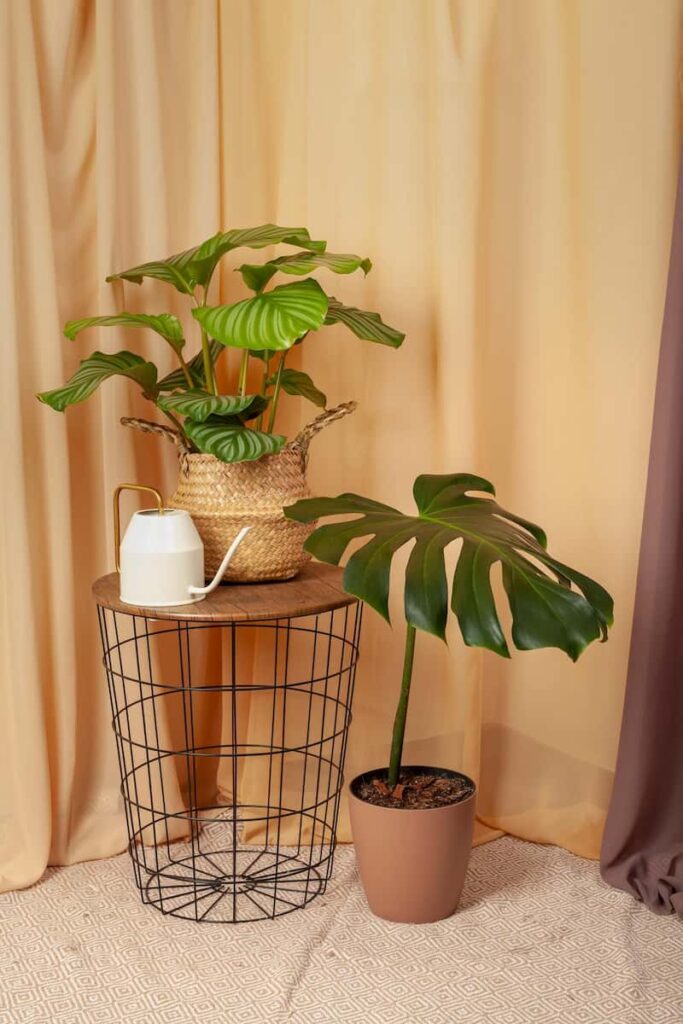
3. Inadequate lighting conditions
Allowing the Calathea to grow in direct sunlight is another potential reason as to why your Calathea leaves standing up. Direct sunlight is too harsh for these sensitive plants, which can result in burned, scorched, discolored, and curled leaves.
A good general rule of thumb is to provide the Calathea with 8 to 10 hours of bright, indirect light every day.
If you give the plant too much sun, then its leaves can start to curl. Too little sun and the foliage of this plant will begin to discolor and fall off the plant.
4. Stress caused by a change in their environment
If you move the Calathea from one room to another, and the temperature or overall environment is different, it can cause the plant to become stressed.
This stress can lead to the Calathea leaves pointing up.
5. Excessive heat
Too much heat will cause the Calathea leaves to curl upward. It can also result in the leaves becoming dry, crispy, and fall off the plant.
If you don’t correct the problem, the plant will stop growing and die.
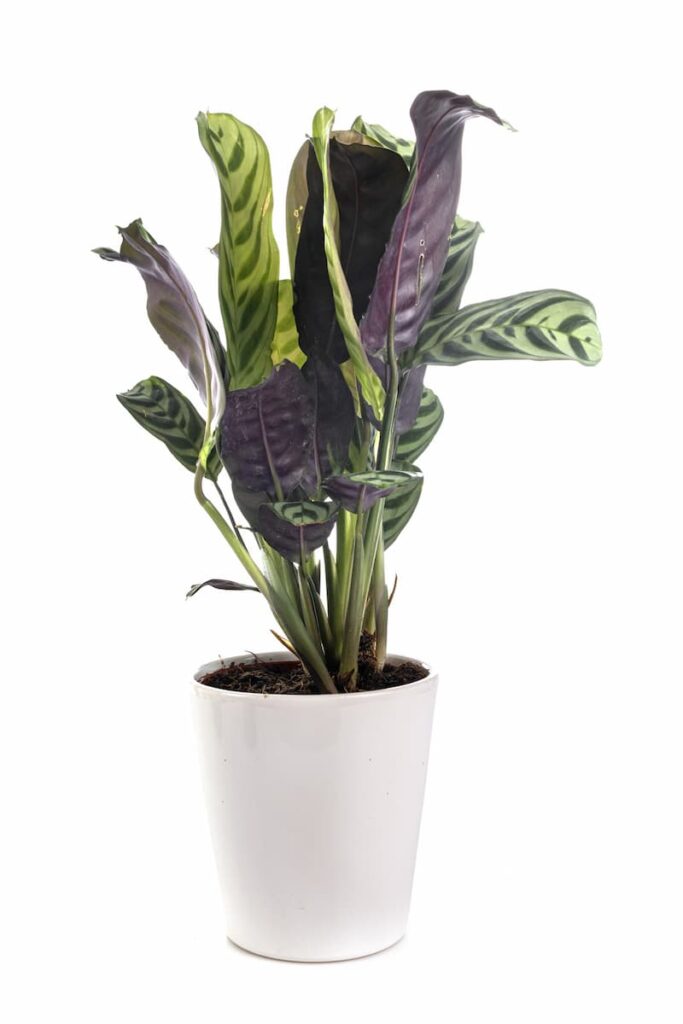
6. Temperatures that are too low
If you allow the Calathea to grow in temperatures that are too low, the plant will go through the process of shock.
This will cause the calathea leaves to curl and potentially fall off the Calathea. If not corrected, Calathea will succumb to the shock and die.
7. Overfertilizing
Another cause of the Calathea leaves standing up is overfertilizing. While it may sound like a good thing, adding too much fertilizer can actually harm the plant.
The excessive amount of nutrients and minerals will build up in the soil, and damage the overall health of the plant.
8. Diseases and pests
There are more than a few diseases and pests that can cause your Calathea leaves standing up, and if left untreated, these problems could potentially prove fatal to the plant.
The best defense against these problems is to prevent them from occurring in the first place. This means quarantining any new plants that you bring into your home.
Keep these plants away from your other plants for at least 14 days to help stop the potential spread of these damaging problems.
Related: 9 Proven Steps to Treat a Calathea With Spider Mites
Why are my calathea leaves standing up at night?
The reason that your Calathea leaves are standing up at night is due to nyctinasty. This process is common, natural, and nothing to worry about at all. While it may be a little odd to see this occur, it is a sign that your plant is functioning as it is supposed to.
Keep in mind, however, that if there are other symptoms present when the Calathea leaves are pointing up at night, such as leaves falling off the plant, discolored foliage, or stunted growth, then there may actually be something wrong with your Calathea.
In this case, you will need to determine the actual cause of the problem and treat them accordingly. This could be altering the way you currently care for the Calathea, or treat it with fungicide or pesticides.
Is it normal for calathea leaves to be pointing up at night?
It is completely normal for the Calathea leaves to point up at night. Calathea leaves stand up at night because of nyctinasty. This is a natural phenomenon that occurs because the plant is reacting to the changes in light levels.
The nyctinasty process helps the Calathea process photosynthesis better during the day. Not only is nyctinasty naturally occurring, but it can indicate that the plant is healthy.
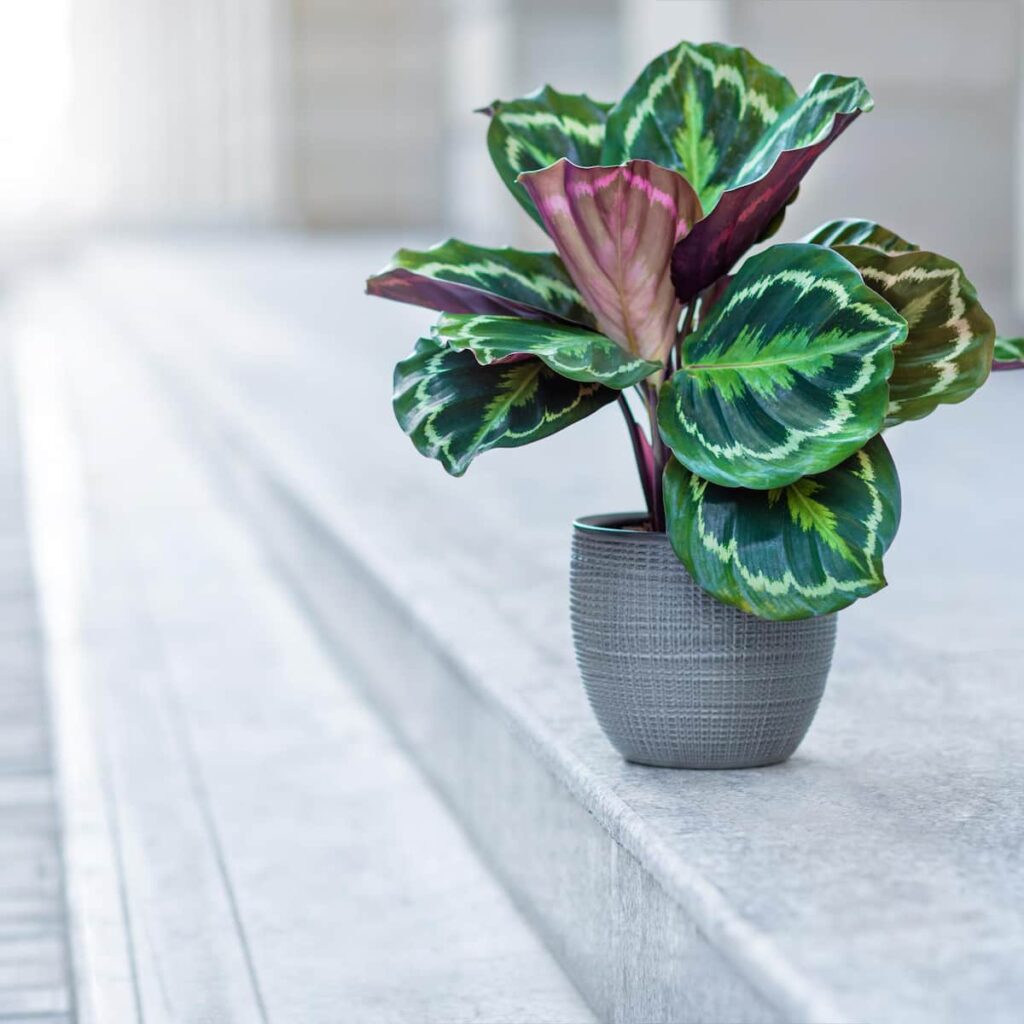
If, however, your Calathea is showing other signs associated with an unhealthy plant, then the Calathea leaves pointing up at night (especially if it also happens during the day) may not be caused by nyctinasty.
In this case, more investigation is needed to ensure you rightfully diagnose the plant and take proper action.
Related: Why Are My Calathea Leaves Not Opening (or Closing at Night)?
How do I prevent calathea leaves from pointing up?
The most common reason why Calathea leaves point up is actually a sign that the plant is healthy so isn’t something you should prevent. However, if it’s from another cause, the best way to avoid this is to provide the plant with its ideal growing requirements.
This means the right amount of water, light conditions, temperature range, and humidity levels.
1. Implement a proper watering schedule for the calathea
Not enough water, as well as too much water, can result in Calathea leaves pointing up. Ensuring the plant is getting the right amount of water will go a long way to prevent this from occurring.
Unfortunately, it can be a bit difficult to get a schedule since it can change based on the time of year, size and age of the plant, and humidity and temperature of the room.
In most cases, the Calathea will need to be watered once every 7 to 10 days. To ensure you water this plant properly, however, you should test the soil moisture level and wait until the top 2 inches is dry.
2. Keep the calathea in the right temperature range
Calatheas need a temperature range that falls between 60 to 85 degrees Fahrenheit. If you go below or above that range, it can cause the leaves to curl.
Thankfully, you can prevent this by ensuring Calathea is in an area with a maintained temperature of between 60 and 85 degrees.
Furthermore, you should avoid placing the Calathea in an area where the temperatures can fluctuate drastically. This includes under heating and cooling vents or next to exterior doors.
These areas cause the temps to rise and fall drastically, and can stress the plant out and cause a slew of problems.
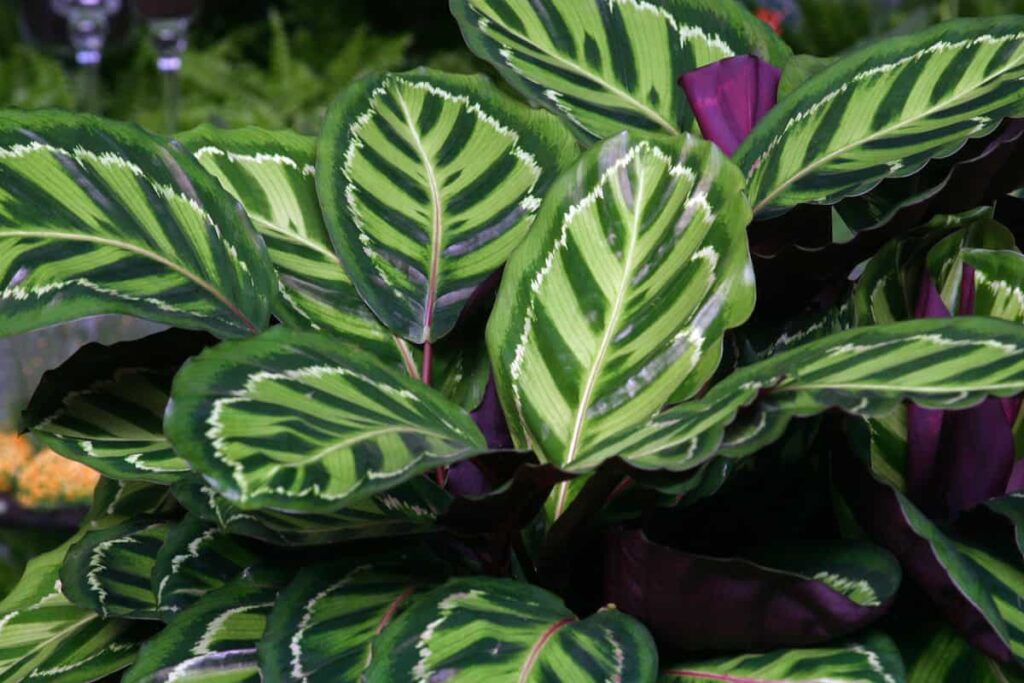
3. Keep the calathea out of direct light
Direct sunlight is just too harsh and damaging for Calatheas, and should be avoided at all cost. The best indoor location for this plant is near an east or south-facing window.
Just make sure the sunlight coming through is diffused by either a sheer curtain or a blind.
If you don’t have a suitable window in your home, you can use artificial lighting as needed. However, the artificial light will also need to be indirect and diffused so as not to damage the Calathea.
Related: Calathea Light Requirements: The Ultimate Guide
4. Increase the humidity in the room
Since dry conditions can lead to the leaves pointing up, making sure the humidity level is above 50 percent will help keep the foliage looking as it should.
You can increase the humidity levels quickly with the help of a humidifier or you can use a drip tray. Drip trays are shallow trays that are filled with small pebbles.
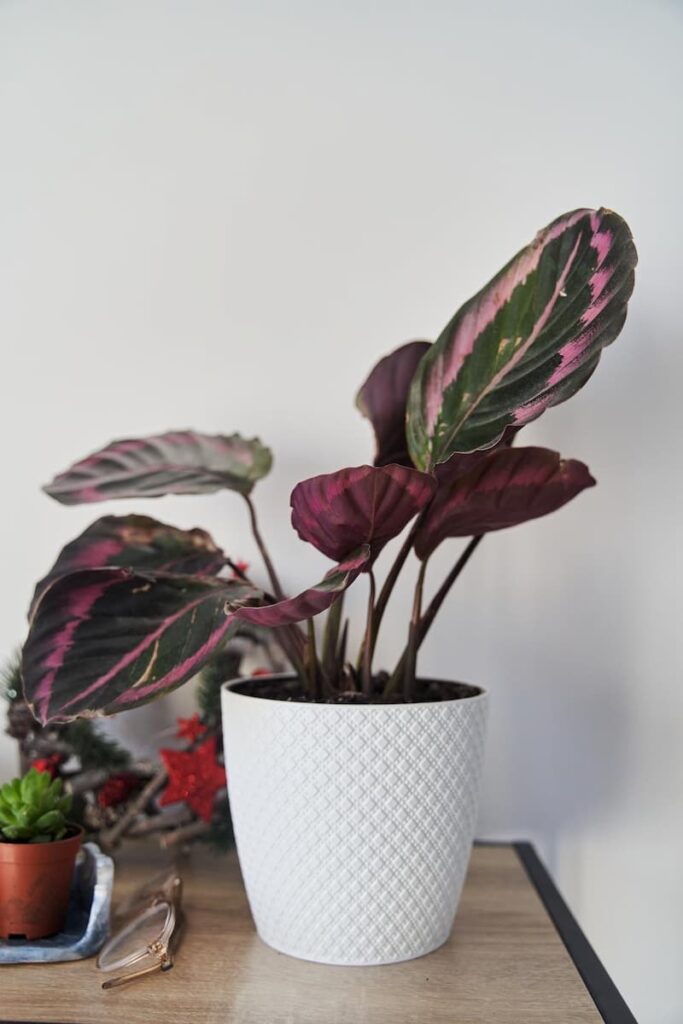
The tray is placed underneath the plant and as the excess water runs out of the pot and into the drip tray, it will naturally evaporate into the air.
Furthermore, you should also mist the Calathea leaves during periods of dry conditions to help push the humidity levels a bit higher and keep the plant hydrated and healthy.
7. Don’t overfertilize the calathea
Giving the Calathea too much or the wrong type of fertilizer can quickly damage the leaves and the plant. That is why it is vital to avoid applying too much fertilizer.
The best fertilizer for this plant is a liquid feed that is balanced, such as a 10-10-10. You should apply this fertilizer no more than once a month at half strength.
During the fall and winter, reduce the amount of fertilizer you give your Calathea to no more than once every 8 weeks.
8. Avoid using tap water to hydrate the calathea
Tap water is not the recommended choice when it comes to watering the Calathea. This is because the Calathea plant is sensitive to the minerals and additives that are often found in tap water.
Things like fluoride and chlorine can damage tropical plants, such as Calathea, and cause issues with its foliage.
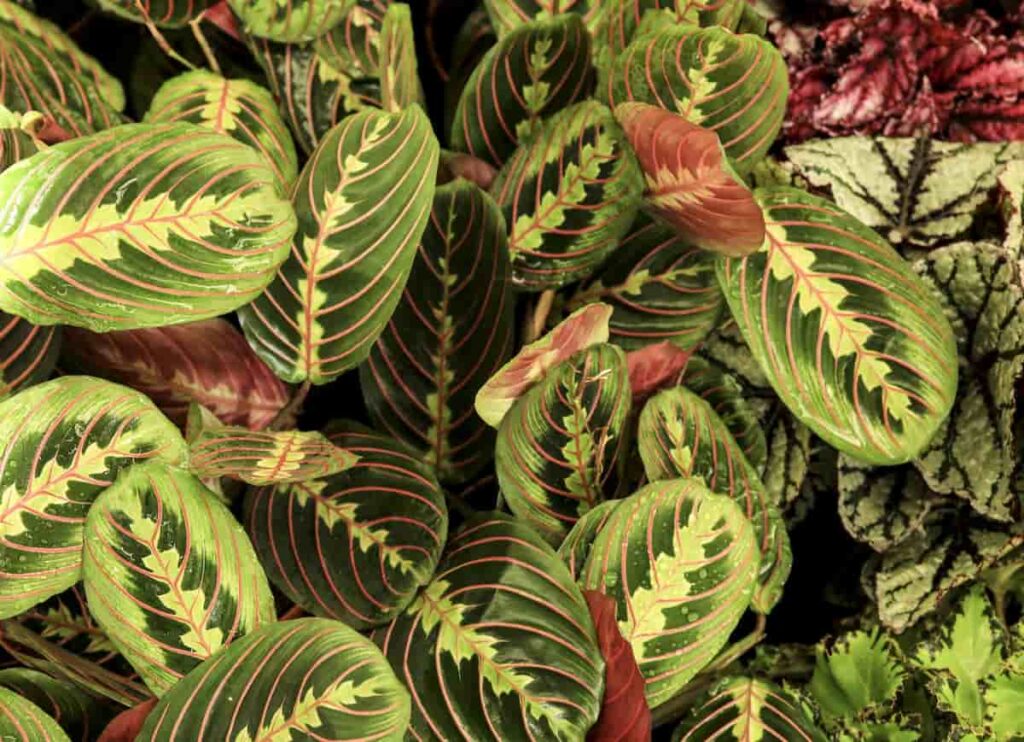
Thankfully, you can prevent this from occurring by using distilled water. Filtered water will also work to help prevent problems associated with tap water. If you only have tap water, let it sit for about 12 to 24 hours before using it to water the plant.
Additionally, when you water the Calathea water at the base of the plant to prevent splashing soil onto the Calathea leaves.
Does overwatering cause the calathea leaves to point up?
Overwatering can cause the Calathea leaves to point up, but it isn’t the most common reason. In most cases, your Calathea leaves standing up is a natural occurrence that happens whenever the Calathea experiences low levels of light, such as what happens at night.
As mentioned above, this means that it’s actually a completely natural phenomenon and not a sign of any problems.
If, however, the Calathea is standing up and has discolored and/or wilted leaves, leaves that are falling off the plant, stunted growth, stem rot, or mushy leaves, then the issue is probably overwatering. Check the soil to confirm whether or not it is overly soggy.
Overly soggy soil will confirm your suspicions that the Calathea is experiencing an overwatering situation that needs to be addressed ASAP.
